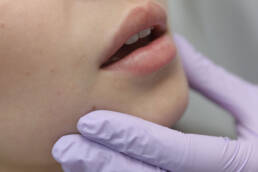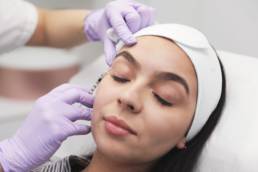
Dermal Fillers
Dermal Fillers are a gel-like substance that contains Hyaluronic Acid, a natural molecule found in skin tissue and other various parts of the body. Dermal fillers are used to replace volume loss due to aging and enhance existing features without surgery. Collagen is what gives volume, flexibility and strength to healthy, young skin. As a part of the aging process, your natural collagen breaks down, diminishing facial volume and elasticity. This loss of elasticity and volume results in wrinkles, facial lines and skin laxity – all of which rob your skin of its youthful, fresh appearance.
After being assessed by a registered health care professional, the hyaluronic acid is injected into the skin and acts like an inflated pillow to support and nourish the surrounding tissues. Hyaluronic acid can absorb significant amounts of water and expand while still feeling natural. Common areas of treatment are cheeks, laugh lines (nasolabial folds), marionettes, jaw, chin, nose, under eyes (tear troughs) and lips. Most dermal fillers contain Lidocaine which makes the treatment comfortable. A topical anaesthetic is also used. Each treatment takes approximately 30-60 minutes and recovery time is minimal
Best of all, the natural-looking results are clinically proven to last up to a year or more in many patients.


Frequently Asked Questions:
Dermal fillers are a soft injectable gel consisting of stabilized, non-animal hyaluronic acid. The gel is tissue-friendly and closely resembles the hyaluronic acid that exists naturally in the body. It is long-lasting but not permanent.
Dermal filler treatments are widely used in medical aesthetics to add volume, plump up and reduce the appearance of line and folds.
Hyaluronic acid is a sugar molecule that occurs naturally in the human body and is central to regulating cell growth and renewal. HA has an impact on a number of functions in the body, some of which are to bind water, lubricate the movable parts of the body such as muscles and joints and to maintain the elasticity of the skin.
Due to the properties of hyaluronic acid, once injected an instant volumizing effect can be seen, giving volume to the skin and longer-term binding with water increasing hydration. Unwanted folds and wrinkles can be “plumped up” to reduce their appearance, resulting in a smoother, more youthful-looking skin.
Dermal filler injections provide an effective way to reduce the appearance of wrinkles, smooth the skin and give a more youthful appearance. The result of a single treatment can be seen instantly and can last for around 6 to 9 months. Dermal filler injections can give natural-looking results that do not affect facial expression. As your face changes over time, dermal fillers allow you to control your looks subtly as you age.
Everybody recalls the tragic results shown by Leslie Ash in early 2000, who received lip filler injections. The product used in her case was an injection of liquid silicone. This has no relationship at all to dermal fillers used today in aesthetic procedures.
There are a few issues and problems with hyaluronic acid fillers, but these are in general very rare. Discuss possible problems with your aesthetic practitioner.
Dermal filler treatments are used to smooth away facial lines and wrinkles, create fuller lips and shape facial contours, such as cheeks and chin, and revitalise the skin.
The most common areas treated are:
Nasolabial folds (lines between the nose and corner of the mouth) Marionette lines (from the corner of the mouth downwards) Lips (Enhance the shape, definition and volume of lips)
BEFORE
All treatments follow a detailed pre-treatment consultation. At this consultation, you will discuss the look you wish to achieve. You will be advised of which treatments will be most effective at helping you reach this. If you decide to proceed, your health care professional will make a detailed recording of your medical history and conduct a careful examination of your face.
Following this, the proper dermal filler option for your requirements and how you can expect to look afterwards will be
outlined.
DURING
The dermal filler is gently injected into specific areas of your skin to reduce the depth of the skin crease. Different dermal fillers can be used in different areas of your face to produce the most effective result.
The procedure can take between 15-60 minutes (depending on the amount of filler desired) and the results are immediately visible.
Patients can continue with their normal day after treatment.
AFTER
You should leave the treated area alone for 48 hours to let it settle. It is advised that you do not have a facial or similar treatment that may disturb the products or expose the newly- treated areas to strong sunlight for 2-3 days.
In the days after the treatment, there may be some redness and minimal swelling, which normally settles in 1-2 days. Very occasionally, patients can suffer some bruising at the injection site.
One of the great advantages of dermal filler treatment is that the effects are long lasting but not permanent. Duration depends on many factors, such as the area treated, individual’s skin type, skin condition lifestyle and age. Generally, the effects can last between 6-12 months.
Some clients may experience the treatment as a mild discomfort. The lips are extremely sensitive and as such, cause the most discomfort. Ranges of dermal fillers containing local anaesthetic are available which ease any discomfort. Some clinics use local anaesthetic creams which are applied 30 minutes or so prior to treatment, which will ease any discomfort.
Product related reactions are rare. There are some injection-related reactions which may occur after any injection including, redness, swelling, pain, itching, bruising or tenderness at the injection site. After lip enhancement, some swelling is likely for a short period.
You should not have dermal filler injected if you are pregnant or breastfeeding, if you have active cold sores, if you have skin infections or open wounds in the injection area, if you are taking immunosuppressant medication, if you have autoimmune disorders, if you have rheumatoid arthritis, hepatitis or graves disease, or if you have allergies or hypersensitivity.